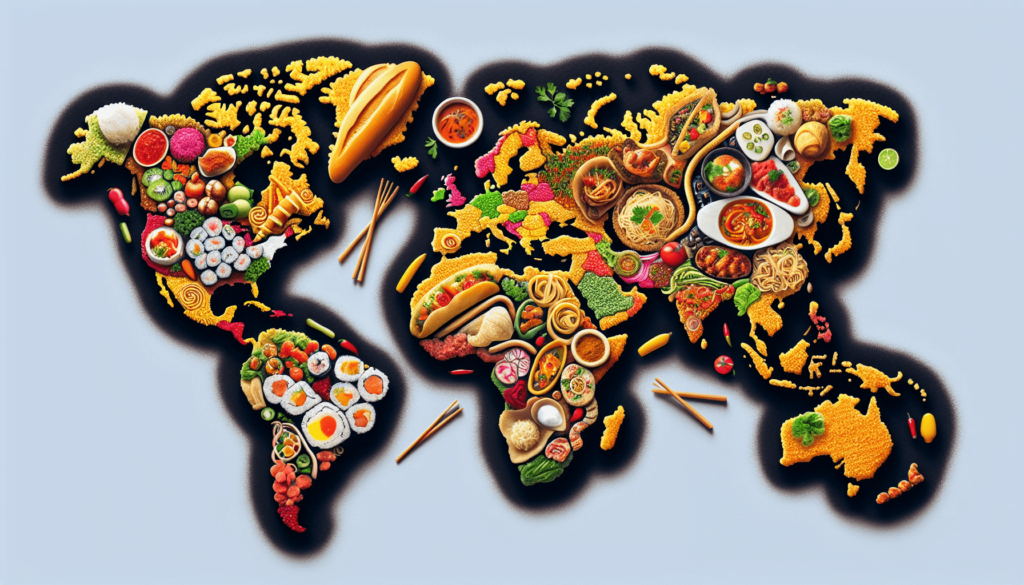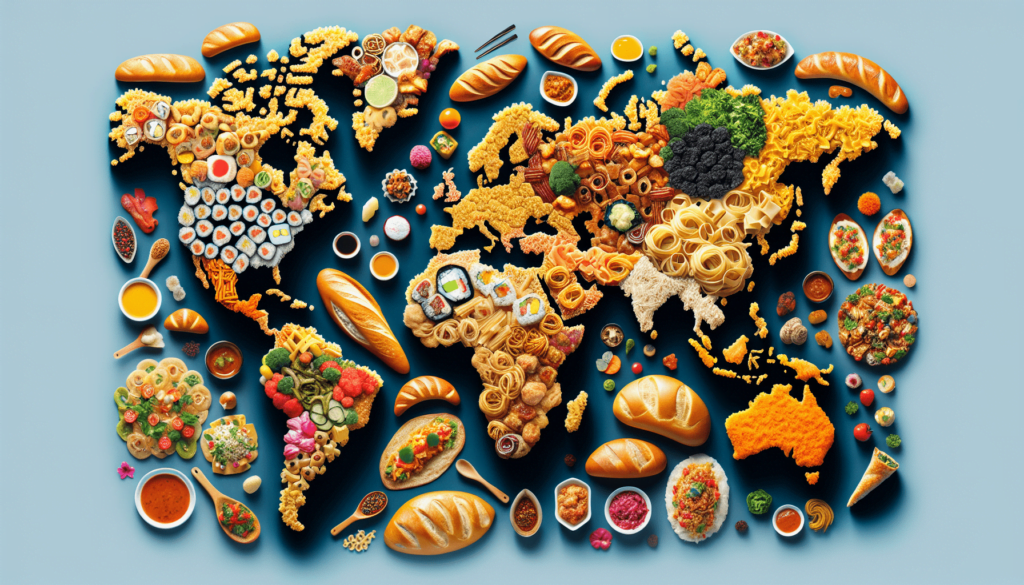Welcome to “A Journey of Tastes: Exploring Global Gourmet Delicacies” – an enchanting adventure that takes your taste buds across continents and through time. Delve into the culinary traditions that have shaped our world, from the intricate spices of India to the refined flavors of French cuisine. This article guides you through the storied evolution of global dishes and highlights the freshest trends captivating food enthusiasts today.
You’ll discover the unique ingredients and cooking techniques that define these gourmet delights and gain a deeper appreciation for the cultural significance behind each bite. Get ready to savor a world where every dish tells a story, promising to deepen your love and understanding of international gastronomy. Have you ever wondered how a single bite of food can transport you to another corner of the world? A mere taste can evoke distant lands, cultural histories, and unique traditions all while awakening your taste buds in ways you never imagined. This journey of flavors is what we will explore in this article, taking you on a virtual tour of global gourmet delicacies.

Table of Contents
Overview
Food acts as a gateway to understanding cultures, fostering connections, and sharing experiences. In our increasingly globalized world, the relevance of exploring international cuisines has never been more poignant. Be it through the resurgence of street food in metropolises or the Michelin-star obsession in gourmet circles, food is at the heart of diverse cultural exchanges. Whether you are a food enthusiast, a globetrotter at heart, or simply curious about what lies beyond your usual plate of spaghetti, this exploration promises to tantalize your senses.
Thesis Statement
In this article, we delve deep into the enchanting world of global gourmet delicacies, understanding their historical roots, current trends, and the future landscapes of these culinary masterpieces. From sushi in Japan to paella in Spain, and from the festive feasts of India to the delicate pastries of France, we’ll take you on a flavorful journey that emphasizes the importance and joy of culinary diversity.
A Journey of Tastes: Exploring Global Gourmet Delicacies
Historical Context
The Roots of Gourmet Cooking
Understanding the history of gourmet delicacies enriches our appreciation of these dishes. Gourmet cooking has deep historical roots, often linked with aristocracy and high society. In medieval Europe, extravagant feasts showcased the power and wealth of nobility. Dishes like foie gras from France or the imperial feasts of China have histories stretching back centuries. Every lavish dish holds a tapestry of stories, from the availability of ingredients to the skill of ancient chefs who first conceived them. The historical journey provides you with a deeper appreciation of the flavors you experience today.
The Influence of Colonization
Colonial histories have played significant roles in shaping modern gourmet palates. The exchange of ingredients, spices, and culinary techniques during the colonial era forever altered the gastronomic landscape. For instance, the introduction of tomatoes to Italy from the Americas or the spices of India influencing British cuisine exemplifies this profound cross-cultural exchange. Thus, every gourmet meal is a blend of various historical influences, rich with the history of human migration, trade, and colonization.
Current Trends
The Rise of Fusion Cuisine
In today’s culinary world, innovation meets tradition in the form of fusion cuisine. Combining elements from different culinary traditions results in creative new dishes. For instance, sushi tacos combine Japanese sushi-making techniques with the Mexican taco tradition – a marriage of flavors that is as intriguing as it is delicious. Fusion cuisine reflects our increasingly connected global society, breaking down the barriers of what food can and should be.
The Farm-to-Table Movement
The farm-to-table movement has gained significant traction as people become more conscious about the origins of their food. This trend emphasizes locally sourced, seasonal ingredients, supporting local farmers and reducing the food industry’s carbon footprint. Restaurants like Blue Hill in New York highlight this trend, offering dishes that revere the purity and freshness of local produce. This movement not only elevates the quality of gourmet dishes but also aligns with sustainability and ethical consumption.

Key Concepts and Definitions
Gourmet
Before diving further, let’s clarify what we mean by “gourmet.” The term refers to food that is of high quality, crafted with specific expertise, and often involving elaborate and artful preparation. It goes beyond mere sustenance, aiming to provide an extraordinary sensory experience.
Delicacy
A delicacy, on the other hand, typically refers to food considered rare or luxurious. It often holds cultural significance and may involve intricate preparation methods. Examples include truffles from Italy and Japan’s pufferfish (fugu), both celebrated for their exclusivity and unique taste profiles.
Detailed Exploration
Now that we have a grasp of the context and key concepts, let’s dig deeper into some specific global gourmet delicacies.
Sushi from Japan
Sushi is more than just raw fish on rice; it’s an art form in Japan. The tradition dates back to the Edo period, evolving from a means of preserving fish to a culinary icon. Chefs like Jiro Ono have elevated sushi to an art form, focusing on the purity of the ingredients, the perfect texture of the rice, and precise knife skills. Sushi has also adapted to global tastes, with variations like California rolls becoming popular worldwide.
Historical Context
Sushi began as fermented fish and rice, evolving over centuries to sashimi-grade delicacies artfully arranged on pressed vinegared rice.
Current Trends
High-end sushi restaurants now offer Omakase experiences, where chefs create a bespoke menu based on the freshest ingredients available each day. Sustainability is also a growing trend, with emphasis placed on sourcing ethical seafood.
Paella from Spain
Paella, hailing from Valencia, is a rustic dish that embodies the spirit of Spanish communal dining. Traditionally cooked over an open fire, it brings together saffron-infused rice with a blend of seafood, meats, and vegetables. Paella is not just a dish but an experience, often shared among friends and family.
Historical Context
Originally a farmer’s meal, paella has its roots in the harvested fields of Valencia, using whatever ingredients were on hand.
Current Trends
Innovative chefs are now playing with paella’s format, incorporating novel ingredients like black rice and octopus while maintaining traditional flavors.
Indian Feast: Thali
India’s thali is a gourmet feast that offers a little bit of everything. It’s a platter of various dishes, providing a comprehensive taste of the region’s cuisine. Each bite of a thali offers a different flavor, from the rich curries to the tangy pickles and sweet desserts.
Historical Context
Thali has its roots in Indian royal traditions where kings would be served an assortment of delicacies on a single platter.
Current Trends
In modern restaurants, thalis are being reimagined to include organic and health-focused dishes, maintaining the essence of Indian feast while aligning with current health trends.
French Pastries
French pastries like croissants, éclairs, and macarons epitomize the sophistication and precision of French gourmet cooking. Techniques passed down through generations ensure that these pastries offer a perfect balance of flavors and textures.
Historical Context
The origins of French pastry lie in royal kitchens, with techniques honed in small patisseries across the country over centuries.
Current Trends
Today, French pastry chefs are innovating with flavors, incorporating unexpected ingredients like matcha or yuzu, while still mastering the stringent traditional techniques.
Example 1: Danish Smørrebrød
Smørrebrød is an open-faced sandwich that originated in Denmark but has gained popularity globally. It serves as an example of how local, simple ingredients can create gourmet experiences. Typically made with rugbrød (rye bread), it is layered with toppings like pickled herring, boiled eggs, and fresh herbs.
Supporting the Thesis
Smørrebrød supports the thesis by showing how a traditional, humble meal can evolve into an internationally acclaimed gourmet dish through attention to ingredient quality and presentation.
Data and Credible Sources
According to culinary historians, smørrebrød has been a staple in Danish cuisine since the 19th century. Modern chefs like Adam Aamann have revived its popularity, bringing traditional recipes into contemporary dining settings.
Example 2: Peruvian Ceviche
Ceviche, a dish of raw fish cured in citrus juices, is a cornerstone of Peruvian cuisine. Its fresh, vibrant flavors highlight the natural quality of the ingredients and the skills required to prepare it to perfection.
Relevance to the Main Topic
Ceviche exemplifies how the use of local ingredients and traditional techniques result in a globally celebrated gourmet delicacy.
Data and Credible Sources
Chef Gastón Acurio has been pivotal in bringing Peruvian cuisine, including ceviche, to the global stage. His restaurants and cookbooks have earned international acclaim, spotlighting the richness of Peruvian culinary traditions.
Comparison of Different Perspectives
Traditional vs. Modern Approaches
There is a constant debate in the culinary world about the merits of traditional versus modern approaches. Traditionalists argue for the preservation of age-old techniques and flavors, believing that these offer the true essence of a culture’s cuisine. Innovations and new techniques, however, bring excitement and relevance to gourmet dining, attracting new generations of food enthusiasts.
Impacts of Both Perspectives
The preservation of traditional methods provides cultural continuity and authenticity, vital for maintaining a connection with history. On the other hand, modern approaches ensure that cuisines stay dynamic, appealing, and accessible to wider audiences.
Future Directions and Implications
Predictions
Looking ahead, the focus is likely to remain on sustainability, ethical sourcing, and inclusivity in gourmet cuisines. Technologies like AI and 3D printing could also revolutionize culinary arts, providing tools for precision and innovation.
Broader Implications
This shift not only benefits the environment but also encourages a more holistic approach to gourmet dining, emphasizing wellness and ethical considerations. The integration of technology promises to break new grounds in culinary techniques and presentations.
Conclusion
Recap
Throughout this journey, we have explored the rich histories, current trends, and future directions of global gourmet delicacies. From sushi in Japan to the festive Indian thali, we have seen how traditional and modern elements intertwine to create extraordinary culinary experiences.
Final Thought
Next time you sit down to enjoy a gourmet meal, take a moment to savor not just the flavors but the stories, traditions, and cultures that each bite represents. It’s a small world after all—remarkably connected through the universal language of food.
Engagement
We’d love to hear about your own culinary journeys and experiences. Feel free to comment below, share this article with fellow food enthusiasts, and explore more resources on global gourmet delicacies. Let’s continue this delicious conversation!
Credible Sources
- “Sushi: Taste and Techniques” by Kimiko Barber and Hiroki Takemura
- “Paella: Spain’s Signature Rice Dish from Valencia” by Alberto Herraiz
- “Indian Thali: Traditional Plates” by Patricia Brown
- “French Pastries and Desserts by Lenôtre” by Gaston Lenôtre
- Aamanns of Copenhagen: www.aamanns.dk
- Gastón Acurio’s Official Website: www.gastonacurio.com
Embark on your culinary adventure and let the world of global gourmet delicacies inspire you, one bite at a time.
